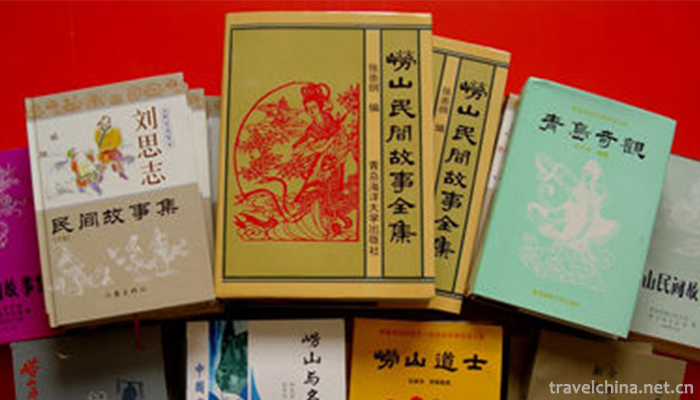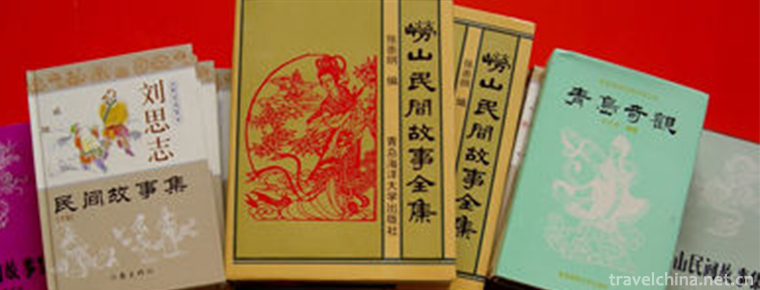Laoshan Folk Stories
Laoshan Folk Stories
Laoshan folk tales, commonly known as Lagua, are oral literature created by the local people of Laoshan Mountain in Shandong Province for thousands of years. There were few written records before liberation.
On June 7, 2008, Laoshan folk tales were listed in the second batch of national intangible cultural heritage list with the approval of the State Council.
Historical origin
Laoshan folktales have a wide range of categories, a large number and rich content. From the collected content of Laoshan folktales, it can be inferred that Laoshan folktales first occurred in ancient times. According to the biography of Pu Songling in Shandong Province, in April of the eleventh year of Kangxi (1672), Pu Songling, 32, traveled to Laoshan with the local gentry Gao Hu and Tang Menglai. Inspired by the folklore stories of Laoshan at that time, he wrote short stories Xiangyu and Laoshan Taoists on the theme of enduring winter, peony and Laoshan Taoists, which were also the earliest writings of Laoshan folk stories.
primary coverage
The contents of Laoshan folktales include "myths", "legends", "stories" and so on, covering more than 5600 natural change myths, heroic myths, historical legends, religious legends, fairy tales, mountain and river legends, specialty legends, ghost and fox ghost stories, animal stories, life stories, wit character stories, etc. Influenced by nature, geographical environment and Taoist culture, among the local folktales in Laoshan, the most numerous and distinctive ones are the legends of local customs, religious figures, ghosts and foxes, ghosts and ghosts, and sea stories.
Inheritance significance
Laoshan folk tales are characterized by the convergence of local popular culture and mountain and sea culture, and evolve in the mutual penetration of secular culture and religious culture, with distinct regional characteristics. It has high historical and literary value.


-
1.century eggspreserved egg100years egg
Preserved egg, also known as preserved egg, egg, egg, egg, etc
Time 2018-10-12 -
4.Laoshan Scenic SpotQingdao Shandong Province
Laoshan Scenic Area of Qingdao, located in Qingdao City, Shandong Province, is one of the first national key scenic spots approved and announced by the State
Time 2018-12-08 -
5.Niangziguan Scenic Area
Niangziguan is a famous pass of the Great Wall of China, known as the Ninth Pass of the Great Wall of China, and it is a must for military strategists of all dynasties.
Time 2019-02-07 -
6.Huaibei Bangzi Opera
Huaibei Bangzi Opera originally named Shahe Diao, also known as Shahe Bangzi, Anhui Bangzi Opera, and Henan Henan Henan Opera belong to a different genre, is popular in Anhui Province
Time 2019-05-04 -
7.Jingzhou Huagu Opera
Jingzhou Huagu Opera, a local traditional drama in Hubei Province, is one of the national intangible cultural heritage.
Time 2019-05-08 -
8.Pingyao Shage Player
Pingyao Shage Opera, commonly known as Shage Renren, also referred to as Shage, is one of the traditional handicraft techniques in Pingyao, Shanxi Province. Because it was usually placed in the cabine
Time 2019-06-09 -
9.Womens clothing in Yongzhishui Townshi Suzhou
The women's clothing in Yongzhishui Township, Suzhou, is an outstanding representative of the Han nationality's clothing. It is a typical and representative clothing of the working people in Wu area.
Time 2019-06-17 -
10.Du Mu
Du Mu (803 years - 852 years), Zi Mu Zhi, Fan Chuan Chuan, Han, Jing Zhao Wan (now Shaanxi Xi'an). Du Mu is Tang dynasty Outstanding poets, An essayist The prime minister. Du you Sun, Du from Yu Son.
Time 2019-09-07 -
11.Concept of Cheongsam
Whether "Qipao" refers specifically to the Qipao in the Republic of China or includes the "Qiren's Robe" or "Qinu's Robe" in the Qing Dynasty. The definition of the concept of Qipao is as controversial as the origin style of Qipao.
Time 2020-12-11 -
12.Guangan economy
In 2019, the GDP of Guang'an City will reach 125.04 billion yuan, an increase of 7.5% over the previous year (the same below). Among them, the added value of the primary industry was 20.43 billion yuan, an increase of 2.8%; the added value of the secon
Time 2020-12-19